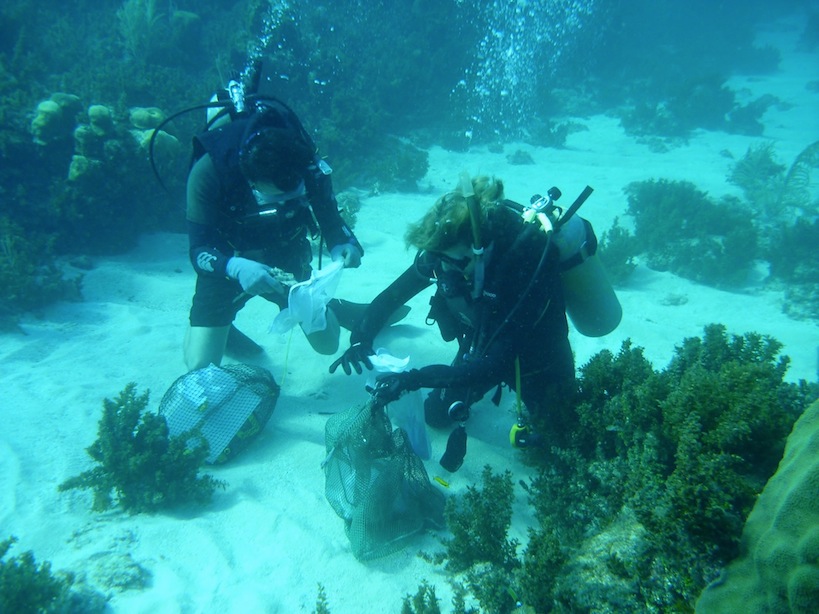 Discovery Bay, Jamaica. 8:23 PM. End of my second full (long) day since arriving Friday afternoon. Kristin, James, and Solomon had arrived Tuesday — three days ahead of me – and made good progress reconnoitering and sampling at the sites we’d worked in 2008. By this evening we had collected and processed over 100 samples of sponges and dead coral rubble, and scored several colonies of our primary quarry: the social shrimp Synalpheus regalis and Synalpheus duffyi.
Discovery Bay, Jamaica. 8:23 PM. End of my second full (long) day since arriving Friday afternoon. Kristin, James, and Solomon had arrived Tuesday — three days ahead of me – and made good progress reconnoitering and sampling at the sites we’d worked in 2008. By this evening we had collected and processed over 100 samples of sponges and dead coral rubble, and scored several colonies of our primary quarry: the social shrimp Synalpheus regalis and Synalpheus duffyi.
The weather is fairly predictable here: Calm at daybreak, with the breeze stiffening as the atmosphere warms through the morning. White-capped seas are typical in the afternoon. Hence we arrived the dock at 0700, and eventually got all parties on board to depart.
Our first stop is the reef at Rio Bueno, at the edge of the reef platform a bit west of Discovery Bay on the north shore of the island. A fresh and promising day, with blue skies and excellent visibility on the bottom, though the chop is already up by mid-morning when we go under. From our vantage on the water the uplifted Pleistocene reefs of the island are clearly visible as a long wall of limestone cliffs parallel to shore and clothed with tropical forest. We submerge and head for the drop-off, scanning constantly for the partially consolidated reef rubble that signals the presence of cryptic sponges and the shrimps that call them home.

I am pleasantly surprised by the high coral cover at Rio Bueno. For years Jamaica has served as a poster child for a global trend in decaying coral reef ecosystems – overfished and with once luxurious coral gardens long gone, and replaced by algae. There is no question that Discovery Bay has been hard hit – on my last trip here in 2008 I was stunned by the boneyard aspect of the forereef. And the elkhorn and staghorn corals that dominated shallow reefs of Jamaica and most of the Caribbean in the 1970s – and indeed for at least the past few thousand years — are hardly to be seen. The reef has shifted to a very different composition, even where coral cover is high. And the new dominants appear vigorous . . .
As John has noted here before, there are signs of hope. We saw many – albeit scattered and small – colonies of the once mighty elkhorn (Acropora palmata) and some staghorn (A. cervicornis) colonies as well. A promising day indeed.
Fish are another story entirely. There are essentially none, at least nothing much larger than a damselfish. During our dives at Dairy Bull reef on the second day we can see why. A line of fish traps, each the size of a small car, extending most of the way along a sand groove in the reef. It’s hard to imagine what is caught in these things or how anyone can make a living working them. I looked up close at one and saw a single jack, maybe a pound and a half, and a trumpet fish. While we were down a boat came by to service them. Meanwhile out on the reef, small schools of various wrasses occasionally pass by. That’s it.
Two dives today and we’re back by 0930. We spend the rest of the morning in the wet lab, picking through coral rock and sponge samples, searching for the tiny shrimp that have diversified explosively to occupy nearly every little nook and cranny in the reef. It is wet, sweaty painstaking work (a hard point to get across to our friends back in the frozen USA) but the tedium is broken up by moments of discovery – a little octopus slithers out of a hole in the rock and inks Kristin, a probable new species of shrimp turns up, a bizarre flatworm uncoils from between coral branches. We spend the rest of the afternoon identifying the shrimp specimens and processing them for study and DNA extraction.
After four days of this schedule, starting at 0630 and finishing often near or after midnight, we at last finish before dark. We wash the tools, pack everything up, lock the lab, and head back to sample the Jamaican rum.
Tomorrow’s another day . . .
Leave a Reply